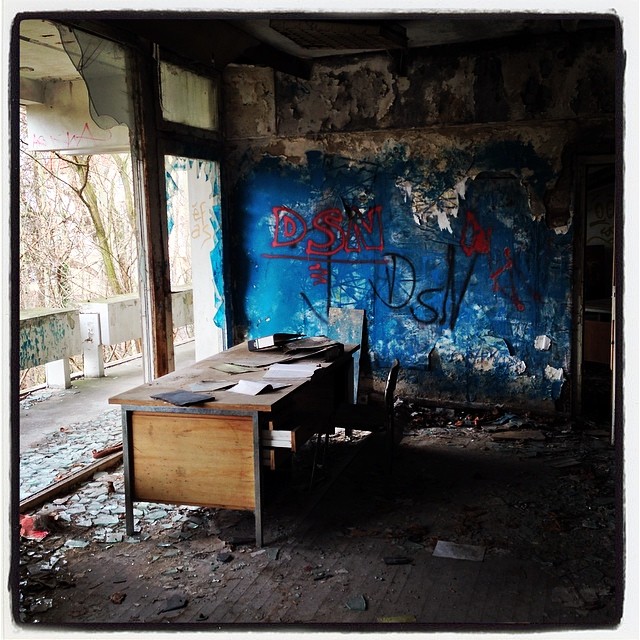
A description of students’ exploration of Pankow’s abandoned Iraqi Embassy.
In the haunted lies the deepest vacuum of the mind, in the ghosts are the people we’ve known, in blank space is everything imaginable.
“Did you hear that?”
“It was just a car.”
“Do you think they saw us?”
“The lights are going in the other direction, they already passed by, just hop over.”
Berlin is a city that is known for vibrating with life at any time of the day or night. But as the city is growing, many places have been left behind to disintegrate on their own. Even these places, the abandoned buildings of Berlin, have their own sort of life as people sit on their roofs for drinks with friends or explore the dark with graffiti walls and rickety staircases. Unlike further into the city, the abandoned buildings in Pankow see very few visitors and still hold their frightening emptiness that makes exploring them so fun.
Our adventure into the abandoned Iraqi Embassy started in the middle of the night:
“Grab your walkie-talkie and a jacket, we’re going on an adventure.”
We walked bundled up with flashlights pointed in front of us to peek through all of the trees and crumbling walls of the building. We looked for holes in the fence, surfaces without spiked wire so that we could climb over. Finally someone just jumped over and the fence became far less daunting as everyone pulled themselves up and inside.
We entered through the front door, an empty frame that opened into lightless rooms. Those with lights walked through first. We could hear only each other’s footsteps and the scratching of the sparse trees surrounding the building; the place had no sound of its own, no comforting hum of the heating or soft voices of people in other rooms. It made me think about all of the noise in my life and how I didn’t actually know what it felt like to hear complete silence. My pipes would always be buzzing, doors opening and closing, water running. It is a sign of life in a home, of habitability, and being in a building that made no sounds of its own felt like walking through empty space.
But it hadn’t chosen to be empty. For years people had been stealing things from the abandoned Embassy – pictures, papers, furniture. Anything valuable as a small keepsake was gone soon after the building had been abandoned in 1991. And what was left behind was destroyed, which seemed to be almost everything. Frames of cupboards and shelves lay in scattered heaps, no window made it out unharmed, papers littered the floor over the glass. We touched the furniture, moved some around to see what it was, or what it had been, but found ourselves drawn to the old papers ripped out and spread around like a thin carpet. It looked as though a bomb had hit. Letters, lists, files were all lying there left behind. They were all in Arabic, with beautiful small script over papers yellowed after many Berlin winters and many shoes pressing down on them. We collected the ones we liked, and continued to look through the destroyed rooms.
It is hard to imagine places as what they used to be, especially if you have never seen them that way. When my family moved into their new house, I always tried to think of how it looked with its previous owner but it was impossible because in my head it was always our house. Abandoned buildings are the same to me – as hard as I try to see what was there before, the sounds, smells, and feelings of right now will overpower my imagination and instead of seeing walls with tiles that are not falling out, I see people walking past those crumbling tiles, over the scattered papers and broken floorboards. It was difficult to see this rotting building being built for the first time in 1974, when now, forty years later, it hid in dark, overgrown brush with a half-heartedly destroyed fence. Once men used to walk through these walls and sit at pristine desks with a typewriter that was clean and work, typing papers that would be placed in orderly files. Now we follow the same path through the halls but the desks are split in two, the typewriter’s keys are torn out and the papers are half burnt on the floor.
There is no way for me to do justice to this place by just describing it. Physically it is torn down and it is destroyed, but mentally it becomes something very personal to each and every person there. Not everyone is afraid of the dark. I was overwhelmed by how open it was; the incomplete walls that fell off like small cliffs made me nervous. To me, buildings are closed and the feeling of the night air coming in through empty door frames that led to a half broken porch was scary. It was empty and your mind fills it in. Unlike many other abandoned buildings in Berlin which are full of people living inside or hanging out with friends or artists drawing on the walls, abandoned areas in Pankow are truly abandoned.
As we walked out, satisfied with our exploration, the sky had become clear and bright with stars.
“You probably didn’t need to bring your binoculars too.”
“You never know.”
